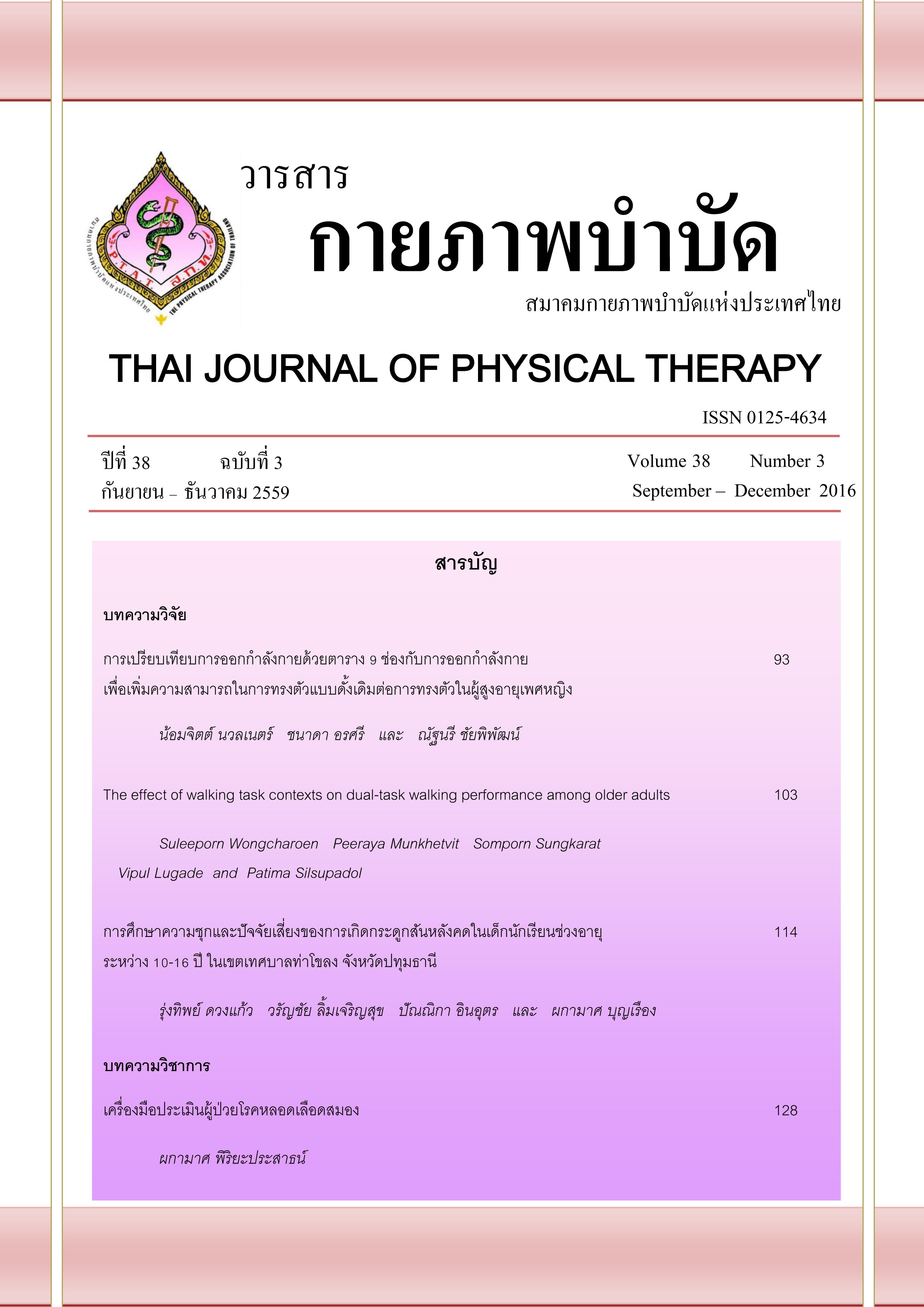การเปรียบเทียบการออกกำลังกายด้วยตาราง 9 ช่องกับการออกกำลังกาย เพื่อเพิ่มความสามารถในการทรงตัวแบบดั้งเดิมต่อการทรงตัวในผู้สูงอายุเพศหญิง
Main Article Content
บทคัดย่อ
ที่มาและความสำคัญ: ความไม่มั่นคงในการทรงตัวเป็นปัญหาสุขภาพประการหนึ่งของผู้สูงอายุ ซึ่งมักจะทำให้เกิดการหกล้มและบาดเจ็บตามมา การออกกำลังกายเป็นวิธีการหนึ่งที่ช่วยเพิ่มความสามารถในการทรงตัวและลดความเสี่ยงต่อการหกล้มของผู้สูงอายุได้ ปัจจุบันการออกกำลังกายด้วยตาราง 9 ช่องเป็นที่แพร่หลายในกลุ่มผู้สูงอายุในประเทศไทย โดยคาดว่าน่าจะช่วยพัฒนาการทรงตัวของผู้สูงอายุได้ แต่ยังไม่พบการศึกษาเกี่ยวกับเรื่องนี้อย่างชัดเจน
วัตถุประสงค์: เพื่อศึกษาผลของการออกกำลังกายด้วยตาราง 9 ช่องต่อการทรงตัวและความแข็งแรงของกล้ามเนื้อขาในผู้สูงอายุ
วิธีการ: อาสาสมัครคือผู้สูงอายุเพศหญิงที่อาศัยใน 2 ชุมชนของอำเภอเมือง จังหวัดขอนแก่น โดยชุมชนหนึ่งถูกสุ่มเป็นกลุ่มทดลอง (คือกลุ่มที่ได้รับโปรแกรมการออกกำลังกายด้วยตาราง 9 ช่อง จำนวน 7 คน อายุเฉลี่ย 72.0 ปี) ส่วนอีกชุมชนหนึ่งถูกสุ่มเป็นกลุ่มควบคุม (คือกลุ่มที่ได้รับโปรแกรมการออกกำลังกายเพื่อเพิ่มความสามารถในการทรงตัวแบบดั้งเดิม จำนวน 7 คน อายุเฉลี่ย 71.3 ปี) ตัวแปรของการศึกษา ได้แก่ การทรงตัว (ซึ่งประเมินด้วย Timed Up and Go Test และ Berg Balance Scale) และความแข็งแรงของกล้ามเนื้อขา (ซึ่งประเมินด้วย 30-second chair sit to stand test) โดยประเมินก่อนและหลังได้รับโปรแกรมการออกกำลังกายเป็นเวลา 4 สัปดาห์ วิเคราะห์ผลการศึกษาด้วยสถิติ Independent t-test
ผลการศึกษา: เมื่อสิ้นสุดการศึกษา อาสาสมัครกลุ่มทดลองมีความแข็งแรงของกล้ามเนื้อขามากกว่ากลุ่มควบคุมอย่างมีนัยสำคัญทางสถิติ (P=0.03, ความแตกต่างระหว่างกลุ่ม 3.11 ครั้ง, 95% CI 0.34 ถึง 5.88 ครั้ง) ส่วนตัวแปรการทรงตัวพบว่ามีความแตกต่างกันระหว่างกลุ่มอย่างไม่มีนัยสำคัญทางสถิติ
สรุปการศึกษา: การออกกำลังกายด้วยตาราง 9 ช่องมีผลต่อการทรงตัวของผู้สูงอายุเช่นเดียวกับการออกกำลังกายเพื่อเพิ่มความสามารถในการทรงตัวแบบดั้งเดิม จึงอาจเป็นทางเลือกหนึ่งสำหรับการออกกำลังกายเพื่อพัฒนาการทรงตัวของผู้สูงอายุได้
Article Details
เอกสารอ้างอิง
2. Berg KO, Maki BE, Williams JI, Holliday PJ, Wood-Dauphinee SL. Clinical and laboratory measures of postural balance in an elderly population. Arch Phys Med Rehabil. 1992; 73: 1073-80.
3. Gulsatitporn S. Physical therapy in the elderly. 2nd ed. Bangkok: Offset Press Publisher; 2006.
4. Silsupadol P. Exercise as an intervention for preventing falls in community-dwelling older adults. Thai J Phys Ther. 2012; 34: 180-92.
5. Krabuanpatana C. The 9-square exercise and brain development. Bangkok: Grand Sport Group, 2007.
6. Hemhong P. The effect of the matrix of nine squares training and flexibility on agility [Master Thesis in Sport Science]. Bangkok: The Graduate School, Kasetsart University; 2011.
7. Kerdjarean S. The effect of the matrix of nine squares training on a table with the speed of 90 and 120 times per minute on hand reaction of boy students aged 7-8 years. [Master Thesis in Sport Science]. Bangkok: The Graduate School, Kasetsart University; 2008.
8. Neelapaijit N. The effects of footwork training using different size of nine square on 25 meter running speed [Master Thesis in Sport Science]. Bangkok: The Graduate School, Kasetsart University; 2006.
9. Philuke P. The Effect of Training using Different Size of Nine-Square on Response Time [Master Thesis in Sport Science]. Bangkok: The Graduate School, Kasatsart University; 2009.
10. Ronnarithivichai C, Thaweeboon T, Petchpansri S, Sujijantararat R, Boonchan N, Kridiborworn C. The evaluation of physical fitness before and after 9-square-table aerobic exercise and rubber ring stretching of elders in the health promotion program for the elderly, Faculty of Nursing, Mahidol University. J Nurs Sci. 2009; 27: 68-77.
11. Cheunsakulpong T, Abthaisong O. The effect of moving the body in the nine squares table with balance and memory in geriatric psychiatric patients who admitted in Prakaisuk ward. J Srithanya Hospita. 2012; 13: 16-25.
12. Ministry of Public Health. A manual of screening/assessment for the elderly. Bangkok: The War Veterans Organization Office of Priniting Mill; 2014.
13. Chirawatkul A. Biostatistics for health science research. Khon Kaen: Klang Na Na Vithaya; 2008.
14. Laophosri M, Kanpittaya J, Sawanyawisuth K, Auvichayapat P, Janyacharoen T. Effects of traditional Thai dance on balance in Thai elderly. Chula Med. 2013; 57: 345-58.
15. Podsiadlo D, Richardson S. The timed “Up & Go”: a test of basic functional mobility for frail elderly persons. J Am Geriatr Soc. 1991; 39: 142-8.
16. Berg K, Wood-Dauphinee S, Williams JI, Gayton D. Measuring balance in the elderly: preliminary development of an instrument. Physiother Can. 1989; 41: 304-11.
17. Skelton DA, McLaughlin AW. Training functional ability in old age. Physiotherapy. 1996; 82: 159-67.
18. Lord SR, Ward JA, Williams P, Anstey KJ. Physiological factors associated with falls in older community-dwelling women. J Am Geriatr Soc. 1994; 42: 1110-7.
19. McCarthy EK, Horvat MA, Holtsberg PA, Wisenbaker JM. Repeated chair stands as a measure of lower limb strength in Sexagenarian woman. J Gerontol. 2004; 59A: 1207-12.
20. Borg GA. Psychophysical bases of perceived exertion. Med Sci Sport Exer 1982; 14: 377-81.
21. Mangione KK, Craik RL, McCormick AA, Blevins HL, White MB, Sullivan-Marx EM, et al. Detectable changes in physical performance measures in elderly African Americans. Phys Ther. 2010; 90: 921-7.
22. Godi M, Franchignoni F, Caligari M, Giordano A, Turcato AM, Nardone A. Comparison of reliability, validity, and responsiveness of the Mini-BESTest and Berg Balance Scale in patients with balance disorders. Phys Ther. 2013; 93: 158-67.
23. Wright AA, Cook CE, Baxter GD, Dockerty JD, Abbott JH. A comparison of 3 methodological approaches to defining major clinically important improvement of 4 performance measures in patients with hip osteoarthritis. J Orthop Sports Phys Ther. 2011; 41: 319-27.
24. Shumway-Cook A, Brauer S, Woollacott M. Predicting the probability for falls in community-dwelling older adults using the timed up & go test. Phys Ther. 2000; 80: 896-903.
25. Berg K, Wood-Dauphinee S, Williams JI, Maki B. Measuring balance in the elderly: validation of an instrument. Can J Pub Health. 1992; 2: S7-11.21.
26. Silpakit O. Srithanya stress scale. Journal of Mental Health of Thailand. 2008 Sep;16(3):177-85.


